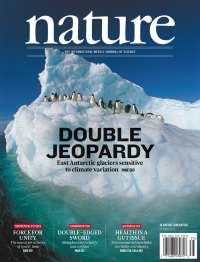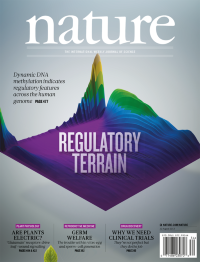Volume 500
-
No. 7464 29 August 2013
A group of Adelie penguins rides a sculpted iceberg in Adelie Land, East Antarctica. It is widely known that glaciers in West Antarctica and Greenland have been discharging ice into the oceans in response to warming in recent years, and that sea levels have risen as a result. By contrast, we hear little about the much larger East Antarctic ice sheet, which has been viewed as being less vulnerable to climate change owing to its location in an extremely cold climate. Chris Stokes and colleagues have used satellite imagery to map a large sample of glaciers along the Pacific coast of East Antarctica and show that in fact, they are responding to decadal climate variability. In concert with climate, glaciers retreated in the 1970s and 1980s, advanced in the 1990s, and approximately split between advance and retreat since the 2000s. The authors conclude that parts of the worlds largest ice sheet may be more responsive to external forcing than previously recognized. Cover: Colin Monteath/Minden Pictures/FLPA
-
No. 7463 22 August 2013
This plot shows the dynamic methylation landscape of the human genome, where the x axis (left) corresponds to the maximal observed methylation change across 24 human cell and tissue types, y is the median total methylation and z is the density of CpG dinucleotides. The methylation of cytosine, usually at CpGs, is a common feature of epigenetic regulation of gene expression. Most cell types have relatively stable CpG dinucleotide methylation patterns and our understanding of which CpGs participate in genomic regulation is limited. Here, Meissner and colleagues analyse whole-genome bisulphite sequencing data sets across diverse human cell and tissue types and find that only about 22% of CpGs change their methylation state across these. Most of these CpGs are located at putative gene regulatory elements, particularly enhancers and transcription-factor-binding sites. In addition to further clarifying the distribution of DNA methylation, these selected regions with dynamic DNA methylation patterns could help guide more efficient genomic approaches to focus on informative regions, as well as help define regulatory elements. Cover: Bang Wong and Michael Ziller.
-
No. 7461 8 August 2013
The cover represents a rendering of 7 of 950 neurons reconstructed in a piece of mouse retina and their mutual contacts (cyan spheres, 112 of 579,724 contacts) together with their contact matrix (see page 168). Three papers in this issue use the retina as a model for mapping neuronal circuits from the level of individual synaptic contacts to the long-range scale of dendritic interactions. Helmstaedter et al. used electron microscopy to map a mammalian retinal circuit of close to a thousand neurons. The work reveals a new type of retinal bipolar neuron and suggests functional mechanisms for known visual computations. The other two groups studied the detection of visual motion in the Drosophila visual system � a classic neural computation model. Takemura et al. used semi-automated electron microscopy to reconstruct the basic connectome (8,637 chemical synapses among 379 neurons) of Drosophilas optic medulla. Their results reveal a candidate motion detection circuit with a wiring plan consistent with direction selectivity. Maisak et al. used calcium imaging to show that T4 and T5 neurons are divided into specific subpopulations responding to motion in four cardinal directions, and are specific to ON� versus OFF� edges, respectively.(Cover: Julia Kuhl & Winfried Denk)
-
No. 7460 1 August 2013
Cell competition is a homeostasis mechanism, first observed in Drosophila, in which viable but suboptimal cells are eliminated from metazoan tissues. Its biological role is not clear but now Miguel Torres and colleagues demonstrate the phenomenon in action in mammalian tissue for the first time, and suggest a possible function. The authors use an in vivo genetic approach to generate mosaic expression of Myc protein in the mouse epiblast � the embryonic tissue that contains the pluripotent stem cells that generate the whole embryo. They show that cell competition is promoted by a naturally occurring imbalance in Myc dose between neighbouring cells, and demonstrate the elimination of cells with low relative Myc levels through apoptosis. These findings suggest a role for cell competition in the optimization of the epiblast stem cell pool. The cover represents fluorescence-based detection of a cell population shift in embryos undergoing increasing levels of cell competition, from left to right.





